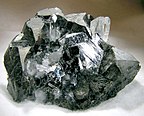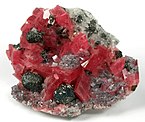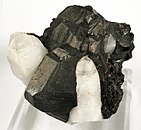Tetrahedrite
| Tetrahedrite | |
|---|---|
 | |
| General | |
| Category | Sulfosalt mineral |
| Formula (repeating unit) | (Cu,Fe) 12Sb 4S 13 |
| Strunz classification | 2.GB.05 |
| Crystal system | Cubic |
| Crystal class | Hextetrahedral (43m) H-M symbol:(43m) |
| Space group | I43m |
| Unit cell | a = 10.39(16) Å; Z = 2 |
| Identification | |
| Color | Steel gray to iron-gray |
| Crystal habit | Groups of tetrahedral crystals; massive, coarse to fine compact granular |
| Twinning | Contact and penetration twins on {111} |
| Cleavage | None |
| Fracture | Uneven to subconchoidal |
| Tenacity | Somewhat brittle |
| Mohs scalehardness | 3+1⁄2– 4 |
| Luster | Metallic, commonly splendent |
| Streak | Black, brown to dark red |
| Diaphaneity | Opaque, except in very thin fragments |
| Specific gravity | 4.97 |
| Optical properties | Isotropic |
| Refractive index | n greater than 2.72 |
| References | [1][2] |
Tetrahedriteis acopperantimonysulfosaltmineral with formula:(Cu,Fe)
12Sb
4S
13.It is the antimony endmember of the continuoussolid solutionseries witharsenic-bearingtennantite.Pure endmembers of the series are seldom if ever seen in nature. Of the two, the antimony rich phase is more common. Other elements also substitute in the structure, most notably iron and zinc, along with less common silver, mercury and lead. Bismuth also substitutes for the antimony site andbismuthian tetrahedriteoranniviteis a recognized variety. The related, silver dominant, mineral speciesfreibergite,although rare, is notable in that it can contain up to 18% silver.
Mineralogy
[edit]Tetrahedrite gets its name from the distinctivetetrahedronshapedcubiccrystals. The mineral usually occurs in massive form, it is a steel gray to black metallic mineral withMohs hardnessof 3.5 to 4 andspecific gravityof 4.6 to 5.2.
Tetrahedrite occurs in low to moderate temperaturehydrothermalveins and in somecontact metamorphicdeposits. It is a minororeof copper and associated metals. It was first described in 1845 for occurrences inFreiberg, Saxony,Germany.Historically, it was an important ore of copper, the formula Cu3SbS3corresponding with 57.5% of the metal; it was also worked as an ore of silver, of which element it sometimes contains as much as 30%.[3]
Applications
[edit]The now-defunct companyAlphabet Energyannounced plans to offer athermoelectricdevice based on tetrahedrite to turn heat into electricity. The company claimed that other thermoelectrics typically produce about 2.5 percent efficiency, while tetrahedrite could achieve 5 to 10 percent.[4]
Other thermoelectrics are either scarce, expensive ($24–146/kg vs $4 for tetrahedrite) and/or toxic. Working with a natural material also reduces manufacturing costs.[4]
Images
[edit]-
Tetrahedrite crystals with chalcopyrite and sphalerite from the Casapalca Mine, Peru (size: 8.2 × 6.4 × 4.7 cm)
-
Tetrahedrite from Casapalca Mine, Casapalca, Huarochiri Province, Lima Department, Peru
-
Rhodochrosite with fluorite, tetrahedrite and quartz; the tetrahedrite occurs as sharp, metallic crystals
-
Tetrahedrite crystals to several inches on size in combination with quartz crystals
See also
[edit]References
[edit]- ^Handbook of Mineralogy
- ^"Tetrahedrite: Tetrahedrite mineral information and data".Mindat.org. 2014-07-12.Retrieved2014-07-17.
- ^One or more of the preceding sentences incorporates text from a publication now in thepublic domain:Spencer, Leonard James(1911). "Tetrahedrite".InChisholm, Hugh(ed.).Encyclopædia Britannica.Vol. 26 (11th ed.). Cambridge University Press. pp. 670–671.
- ^abJacobs, Suzanne (2014-07-12)."Cheaper Thermoelectric Materials | MIT Technology Review".Technologyreview.com. Archived fromthe originalon 2014-07-17.Retrieved2014-07-17.
External links
[edit] Media related toTetrahedriteat Wikimedia Commons
Media related toTetrahedriteat Wikimedia Commons- Hurlbut, Cornelius S.; Klein, Cornelis, 1985,Manual of Mineralogy,20th ed., Wiley,ISBN0-471-80580-7
- Mineral galleries
- Webmineral data




